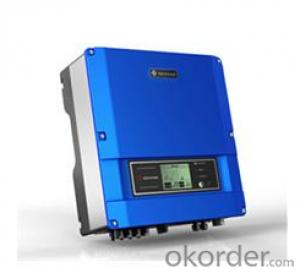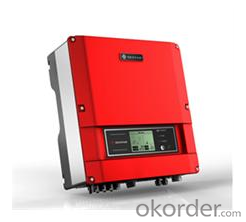1.5 Kw On Grid Solar Inverter GS3600-DS
- Loading Port:
- Shanghai
- Payment Terms:
- TT OR LC
- Min Order Qty:
- 10 unit
- Supply Capability:
- 100 unit/month
OKorder Service Pledge
OKorder Financial Service
You Might Also Like
GW3600-DS
GW3600-DS photovoltaic inverter is suitable for home rooftop photovoltaic system, designed under modern industrial concept. There are three colors for option with fashionable appearance. This model uses digital control technology to achieve Dual-lines MPP tracking. The maximum conversion efficiency is up to 97.6%, THDi is less than 1.5% and the maximum output power is 3600W. It is suitable for the photovoltaic system which open-circuit voltage is less than 580V.
| DC Input Data | Max.PV-generator power[W] | 3800 |
| Max.DC power each MPPT[W] | 2000 | |
| Max.DC voltage[V] | 580 | |
| MPPT voltage range[V] | 125~550 | |
| Turn on DC voltage[V] | 125 | |
Max.DC work current[A] | 2*10 | |
| Number of inputs/MPP trackers | 4/2(can parrallel) | |
| DC connector | MC IV Connector | |
| Self-energy consumption[W] | <5< td=""> | |
| AC Output Data | Nominal AC power[W] | 3600 |
| Max.AC power[W] | 3600 | |
| Max.output current[A] | 18 | |
| Nominal output voltage range | According to VDE-AR-N 4105, RD1663, ENEL, G59,SAA | |
| AC grid frequency | According to VDE-AR-N 4105, RD1663, ENEL, G59,SAA | |
| THDi | 〈2% | |
| Power factor | 0.95 leading...0.95 lagging | |
| AC connection | Single phase | |
| Efficiency | Max.efficiency | 97.6% |
| European efficiency | 96.5% | |
| MPPT adaptation efficiency | >99.5% | |
| Safty Equipment | Leakage current monitoring unit | Integrated |
| DC switch disconnector | Optional | |
| Islanding protection | AFD | |
| Grid monitoring | According to VDE-AR-N 4105,AS4777.1/2/3, RD1663, ENEL,G59-2 | |
| Normative Reference | EMC compliance | EN 61000-6-1,EN 61000-6-2, EN 61000-6-3,EN 61000-6-4 |
| Safety compliance | According to IEC 62109-1,AS3100 | |
| General Data | Dimensions(W*H*D) [mm] | 390*417*165 |
| Net weight [kg] | 20 | |
| Housing | For outdoor and indoor | |
| Mounting information | Wall mounting | |
| Operating temperature range | -20~60℃(up 45℃ derating) | |
| Relative humidity | 0 ~ 95% | |
| Site altitude[m] | 2000 | |
| IP protection class | IP65 | |
| Topology | Transformerless | |
| Cooling | Nature Convection | |
| Noise level[dB] | 〈25 | |
| Display | 4" LCD | |
| Communication | USB2.0;RS485(Wireless/Bluetooth optional) | |
| Standard warranty[years] | 5/10(optional) |
- Q: What is the role of a solar inverter in a solar-powered water purification system?
- The role of a solar inverter in a solar-powered water purification system is to convert the direct current (DC) generated by the solar panels into alternating current (AC) that can be used to power the water purification system. It also ensures the optimal utilization of solar energy by regulating the voltage and frequency of the electricity produced, making it compatible with the requirements of the water purification system.
- Q: How do you choose the right voltage rating for a solar inverter?
- When choosing the right voltage rating for a solar inverter, it is important to consider a few factors. First, you need to determine the voltage of your solar panel array. This will help you match the inverter's voltage rating to ensure compatibility. Additionally, you should consider the voltage requirements of your electrical grid or any appliances you plan to power. The inverter's voltage rating should align with these requirements to ensure efficient energy conversion and safe operation. It is advisable to consult with a professional or an electrical engineer to help you select the appropriate voltage rating for your solar inverter based on your specific needs and system setup.
- Q: Can a solar inverter be used with a remote monitoring system?
- Yes, a solar inverter can be used with a remote monitoring system. Remote monitoring systems are designed to monitor and control the performance of solar inverters from a remote location. This allows users to track and analyze the solar energy production, detect any issues or faults in the inverter, and make necessary adjustments for optimal performance.
- Q: Can a solar inverter be controlled remotely?
- Indeed, remote control of a solar inverter is possible. Numerous contemporary solar inverters are furnished with integrated communication capabilities like Wi-Fi or Ethernet connectivity, granting the ability to monitor and control them from a distance. Users can access and manage their solar inverters from any location with an internet connection through a web-based interface or a dedicated mobile app. The remote control features typically encompass performance monitoring, settings adjustment, and issue troubleshooting. This remote control functionality provides solar system owners with convenience and flexibility, empowering them to maximize energy production and efficiently manage their systems.
- Q: What is the role of a solar inverter in a solar power system?
- The role of a solar inverter in a solar power system is to convert the direct current (DC) electricity generated by the solar panels into alternating current (AC) electricity that can be used to power appliances and devices in homes or businesses. It also regulates and optimizes the flow of electricity to ensure maximum efficiency and safety in the solar power system.
- Q: What is the role of a solar inverter in grid management and stability?
- Solar inverters have a crucial role to play in the management and stability of the electrical grid when it comes to integrating solar power. They are responsible for converting the direct current electricity produced by solar panels into alternating current electricity that can be used by homes and businesses or fed back into the grid. When it comes to managing the grid, solar inverters are vital for maintaining its stability and reliability. They perform important functions such as voltage regulation, frequency control, and compensating for reactive power. By monitoring the grid conditions and adjusting the solar power output accordingly, inverters help to balance the supply and demand of electricity in real-time, ensuring grid stability. In addition to grid management, solar inverters also contribute to grid stability by improving the quality of power. They actively filter out harmonics, voltage fluctuations, and other electrical disturbances that can be caused by the intermittent nature of solar power generation. This ensures that the electricity generated by solar panels is of high quality and does not introduce any disruptions or damage to the electrical grid. Furthermore, solar inverters enable the seamless integration of solar power into the grid by allowing excess energy to be fed back into the system. This is known as net metering or feed-in tariff programs, which provide compensation for solar energy producers for the surplus electricity they produce. With the help of inverters, the generated solar energy can be efficiently transferred to the grid, reducing the reliance on traditional fossil fuel-based power generation and promoting renewable energy integration. In summary, the role of a solar inverter in grid management and stability is to ensure the smooth integration and optimal utilization of solar power while maintaining the stability, reliability, and quality of the electrical grid. It acts as a bridge between solar energy producers and the grid, facilitating the efficient and sustainable integration of renewable energy sources into the existing power infrastructure.
- Q: Can a solar inverter be used in systems with different module tilts?
- Yes, a solar inverter can be used in systems with different module tilts. Solar inverters are designed to convert the DC power generated by solar modules into AC power that can be used in electrical systems. They are typically compatible with a wide range of module tilts and orientations. However, it is important to ensure that the inverter is properly configured to match the specific tilt angles of the solar modules for optimal performance and maximum energy generation.
- Q: How does a solar inverter handle voltage dips or surges in the grid?
- A solar inverter handles voltage dips or surges in the grid by constantly monitoring the grid voltage. In case of a dip or surge, it quickly adjusts its own output voltage to match the grid voltage, thereby stabilizing the grid. This is achieved through various control mechanisms, such as voltage feedback loops and power electronics, which ensure that the solar inverter remains synchronized with the grid and provides a consistent and reliable power supply.
- Q: How does a solar inverter handle electromagnetic interference (EMI)?
- A solar inverter typically handles electromagnetic interference (EMI) by incorporating various measures and technologies to minimize its impact. This includes using shielding materials and techniques to prevent EMI from affecting the internal electronics of the inverter. Additionally, filters and surge suppressors are employed to reduce EMI generated by the inverter from interfering with other electronic devices. Overall, the solar inverter aims to mitigate EMI issues to ensure optimal performance and minimize disruptions.
- Q: What is the difference between a single-phase and three-phase solar inverter?
- A single-phase solar inverter is designed to convert the DC power generated by solar panels into AC power for use in a single-phase electrical system. It is suitable for smaller residential installations. On the other hand, a three-phase solar inverter is capable of converting DC power into AC power for use in a three-phase electrical system. It is typically used in larger commercial or industrial solar installations. The main difference lies in the electrical system they are compatible with and the scale of the solar installation they can support.
Send your message to us
1.5 Kw On Grid Solar Inverter GS3600-DS
- Loading Port:
- Shanghai
- Payment Terms:
- TT OR LC
- Min Order Qty:
- 10 unit
- Supply Capability:
- 100 unit/month
OKorder Service Pledge
OKorder Financial Service
Similar products
Hot products
Hot Searches
Related keywords



























